Sony Alpha A100 Review
Sony Alpha A100 Introduction
The Sony Alpha A100 was the first 10 megapixels digital SLR to sell below $1000 USD. Brought to market by Sony using a sensor first seen on the Nikon D200 and a legacy of technology and optics acquired from Konica-Minolta, the launch of the Alpha A100 generated high-expectations. Months later, the Sony A100 faces many tough competitors: the Canon Rebel XTi, the Nikon D40X, the Nikon D80, the Pentax K10D, the Olympus E-410 and the Olympus E-510.
As expected from a modern DSLR, the Sony Alpha A100 is a full-featured digital camera with full-manual controls, custom white-balance, high-ISO, a wide range of shutter-speeds including a bulb mode, exposure-compensation, interchangeable lenses, continuous drive, an optical viewfinder and a large LCD. Having gotten awards and top-marks from over 10 professional review web sites, it is widely known that this is an excellent camera. However, a quick look at reviews of competing DSLRs reveals that they too are mostly excellent digital cameras. With that in mind, Neocamera takes an in-depth look at what is special and distinctive about the Sony Alpha A100.
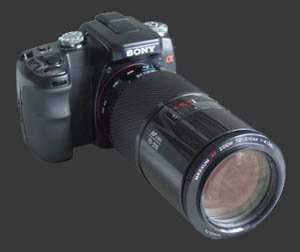
The most important feature of this DSLR is its built-in stabilization. Built-in stabilization can bring both unequaled flexibility and cost savings. There are many types of lenses which do not have any stabilized counterparts, in particular, prime lenses and most bright zooms. This means that photography is possible in darker conditions than without built-in stabilization. The cost saving aspect can also be very important as it saves up to $500 USD per lens. It can also make a standard zoom usable when a bright and more expensive zoom would normally be required. Note that this feature is no longer unique to this 10 megapixels DSLR since it is also found on the Pentax K10D. The recently announced Olympus E-510 will also feature a similar mechanism. Another important feature of the Sony Alpha A100 is its built-in dust-reduction system. At the time of its launch, the Alpha A100 was the only non-Olympus DSLR that sported such system. Since then, everyone but Nikon has implemented this feature.
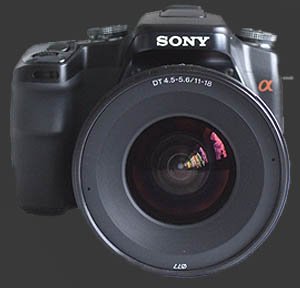
Even though it is the oldest affordable 10 megapixels DSLR, the Sony Alpha A100 still has several unique features: a Dynamic-Range-Optimizer (DRO), dedicated low-key and high-key sensitivities and an eye-start sensor for initiating auto focus. An in-depth discussion of these unique features is included further in this review. As for its more-standard feature set, here it is:
- 10 Megapixels image sensor, 1.5X crop-factor.
- Minolta A-mount, supports nearly all AF Konica-Minolta lenses.
- ISO 100 to 1600, Auto ISO (100-400), Low-key ISO 80 and High-key ISO 200.
- 1/4000s to 30s shutter-speeds, plus bulb mode.
- Metering modes: multi-segment, center-weighed and spot.
- Exposure compensation: -2..+2, 1/3 EV inc.
- Flash compensation: -2..+2, 1/3 EV inc.
- Exposure bracketing, 3 images, 0.3 or 0.7 EV inc.
- Automatic white-balance.
- Preset, Kelvin and custom white-balance, all fine-tunable along green-to-magenta scale.
- 9-point auto-focus system.
- Focus-point selection: automatic, manual or center.
- Focus modes: single-shot, direct-manual (DMF), continuous, auto-switching and manual.
- Full manual controls.
- Unlimited 3 FPS continuous drive.
- 10-second and 2-second self-timers with automatic mirror-lockup.
- Dedicated Auto-Exposure-Lock (AEL) and optional Auto-Focus-Lock (AFL).
- Customizable saturation, sharpness and contrast, 5 steps.
- 2.5" LCD 230K Pixels with automatic rotation of status screen.
- Eye-start sensor automatically controls LCD and optionally starts auto focus.
- 0.83X Magnification viewfinder, 95% coverage.
- Image review with magnification and histogram.
- Depth-of-field preview.
- JPEG and RAW modes.
- Built-in flash.
- Lithium-ion battery.
- Compact flash memory.
Sony Alpha A100 Suitability - What is it good for?
Since DSLR cameras represent the high-end of digital cameras, they are generally suitable for most types of photography. The versatility of interchangeable lenses gives SLR cameras their greatest potential. The Sony Alpha A100 is no exception, it is suitable for every type of photographic subject.
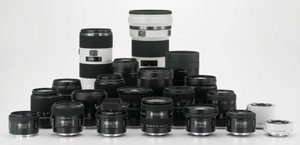
The introduction of 19 lenses along with the Alpha A100 helps keep it versatile. Among these lenses are several highly desirable - and expensive - ones by Carl-Zeiss. Sony sells the A100 alone, with a 18-70mm F3.5-5.6, with a 18-200 F3.5-5.6 or with a 18-70mm F3.5-5.6 and a 75-300 F4.5-5.6. These are all medium quality lenses with typical narrow apertures. The most unique lens among Sony's lineup is the Carl-Zeiss 16-80mm F3.5-4.5 which is equivalent to 24-120mm in 35mm terms. What is special about it is that there are very little zooms which start this wide and none with a 5X or more zoom range. Another high-quality lens from Sony is the ultra-wide 11-18mm F4.5-5.6 which shows excellent sharpness and very little distortion for such focal-length. Several of our image samples were taken with that lens. Numerous lenses are also available from third-party companies such as Sigma. Most out-of-production Konica-Minolta auto focus lenses are also compatible with the A100.
Feature-wise, a few DSLR cameras are better suited for action-photography. Even though the Alpha A100 can shoot at 3 FPS indefinitely, some cameras can shoot faster. Specifically, the 8 megapixels Canon EOS 30D and the 10 megapixels Nikon D200 both shoot continuously at up to 5 FPS. Like all forms of stabilization, Sony's built-in stabilization only compensates for the photographer's movements, never the subject's. In other words, it does not effectively help for action photography.
The Alpha A100 is nor the largest nor the smallest 10 megapixels DSLR. In terms of weight, its also near the middle of its class. Given its size and weight, the Sony A100 has a solid feel without being tiresome to carry. It is certainly no more noticeable than most consumer-oriented DSLR cameras.

Sony Alpha A100 Capability - What can it do?
As noted in the introduction, the Sony Alpha A100 has everything expected from a DSLR plus a few unique features. Headline features include built-in stabilization, renamed Super-Steady-Shot from Konica-Minolta's Anti-Shake, an eye-start sensor, also inherited from Konica-Minolta, a dust-reduction mechanism, an unlimited 3 FPS continuous drive and a unique dynamic-range-optimizer, called DRO.
The camera's only LCD has multiple duties: playing back images, changing camera settings and displaying status information. In shooting mode, the LCD displays the camera status until it is cleverly deactivated by the eye-start sensor situated under the optical viewfinder. As soon as your eye, or any other object, gets near the viewfinder, the LCD is immediately turned off. This no-user-intervention approach is great because it does exactly what needs to be done smoothly. This saves power and prevents the LCD from interfering with the viewfinder's normal use. Using the LCD as a status display makes it easier to check the camera's status between hand-held shots than with a top mounted LCD. However, when using a tripod below eye-level, a top-mounted LCD would be preferable. Another neat trick with the status display is that it automatically rotates with the camera for improved readability.
The eye-start sensor also optionally serves to start the focusing system. This is designed to shorten the time to lock focus by letting the camera start focusing before the shutter-release is half-pressed. How useful this is depends on your shooting style: If you keep your eye to the viewfinder for a while before taking a shot, focus lag can be greatly reduced; If you hang the camera from your neck between shots, you may be annoyed at hearing the camera continuously focus. Either way, this feature can be deactivated in the setup menu.
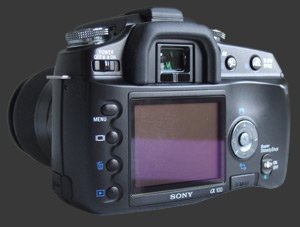
Among several features taken from the Konica-Minolta Maxxum 5D the Sony Alpha A100 offers high-key and low-key modes. In addition to Automatic, 100, 200, 400, 800 and 1600, the ISO can be set to Lo80 or Hi200. These two last settings set the camera's ISO and the tone-curve used to produce JPEG images from the sensor's RAW data. The Lo80 mode is designed to photograph dark subjects while retaining a significant amount of shadow-details. This is done by ensuring that the ISO is very low so that noise does not interfere with shadow-detail and by allocating more brightness levels than normal to the shadow-areas. The Hi200 mode is designed to photograph bright subjects while retaining details in highlight areas. It works by slightly underexposing the image and spreading highlight-detail over a wider range of brightness levels.

New to the Sony Alpha A100 is the DRO which can adjust the brightness levels of photographs before being converted to JPEG. Like the Lo80 and Hi200 modes, the DRO is designed to help with dynamic-range problems. Recall that a camera can only capture a small dynamic range compared to reality. The DRO has 3 modes: Off, Standard and Advanced. Obviously, in the Off mode, the DRO does nothing. The Standard mode adjusts the brightness levels of the image based on the overall image contrast and brightness. The Advanced mode analyses the image and adjusts it differently depending on local brightness and contrast.
The DRO is both powerful and dangerous. The power of the DRO is that it can easily produce pleasing images from high-contrast subjects with shadow and highlight details. The weakness of the DRO is that its effect is hard to predict and may be detrimental to the mood of an image. For example, a high-contrast scene can be rendered relatively flat, thus removing some of the photograph's punch. Also, the DRO cannot fill-in details which have not been captured. Note that the DRO works by modifying the camera's internal RAW conversion used to produce JPEG images. Hence, DRO does not affect RAW images other than influencing exposure.
The white-balance options of the Alpha A100 are similar to most digital SLR cameras. The automatic white-balance option is fixed while any preset and even custom white-balance can be adjusted on a green-to-magenta scale. The presets have 7 positions along the scale, while the custom white-balance has 19. When calibrating custom white-balance, this camera actually reports the Kelvin temperature and the Green-to-Magenta bias. This is useful to return exactly to a previously measured white-balance.
The exposure-mode-dial of the Sony Alpha A100 has 11 positions. Among those are the typical Program (P), Aperture-priority (A), Shutter-priority (S) and Manual (M) modes. There is also an Auto mode which is similar to P but prevents access to some functions. The last remaining positions are for the following scene modes: Portrait, Landscape, Macro, Sports, Sunset and Night portrait. These scene modes affect the way exposure is chosen and image parameters such as color-mode, contrast, sharpness and saturation.
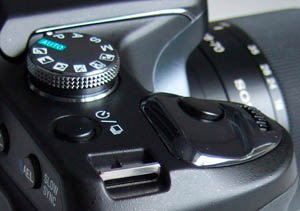
The Auto-Exposure-Lock (AEL) button can be customized in 4 very useful ways. It works either by holding or by toggling. In Hold-mode, the exposure is locked until the AEL button is released. In Toggle-mode, the AEL is locked until either the AEL button is pressed again or the camera enters playback mode. The Toggle-mode is the easiest way to expose for stitched panoramas. The AEL can either use the current metering-mode or spot metering. Having the AEL-button use spot-metering provides a quick way to access spot-metering when faced with difficult lighting. Relative to exposure, a brilliant option is whether Exposure-Compensation (EC) affects ambient or flash+ambient exposure. In ambient-only mode, EC brightens the entire scene including the background. In flash+ambient mode, EC can affect flash output to change the illumination of objects within its range.
This DSLR supports the standard drive modessingle, continuous and self-timer plus 3 bracket modes. In continuous drive mode, it can shoot an unlimited number of JPEG images or up to 6 RAW images. Continuous shooting speed is always 3 FPS. The self-timer can trigger after 2 or 10 seconds. With the 2-second self-timer, the mirror is automatically locked-up. Wisely, the 10-second self-timer is reset after each use which avoids the common mistake of forgetting to reset it. The bracketing modes are: single-step exposure bracket, continuous exposure bracket and white-balance bracket. Each bracketing mode takes 3 shots with either a small step or a large step. The small step is 0.3 EV for exposure-bracketing and 5 mired for white-balance bracketing. The large step is 0.7 EV for exposure-bracketing and 10 mired for white-balance bracketing. Single-step bracket requires the shutter to be pressed for each image in the bracket. Continuous bracket takes all 3 images continuously while the shutter is being pressed. The white-balance bracket is done virtually by taking a single shot and saving it with 3 different white-balance biases.
Given these special features it is clear that the Sony Alpha A100 was designed to simplify the work of photographers. Most importantly, this DSLR is one of the few to provide control over dynamic range. While the Alpha's DRO uses processing to attack the problem, the Fuji Finepix S5 Pro's SuperCCD SR provides a hardware solution. Dynamic range is one of the biggest limitations of digital camera technology and definitely deserves an article for itself.
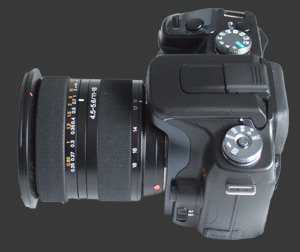
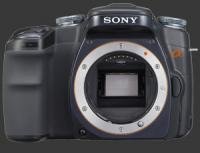 |
Please Support Neocamera
All information on Neocamera is provided free of charge yet running this website is a huge endeavor. Purchases made via affiliate links found throughout the site help keep it running and up-to-date. There is no additional cost to you, so please consider buying via these links to our affilates:
If you found any information on this site valuable and did not purchase via our affiliate links, please considering donating via PayPal:
Any amount will be greatly appreaciated. Thank you for your support!
Sony A100 Highlights

Sensor-Size: 24 x 16mm

Actual size when viewed at 100 DPI
| 10 Megapixels DSLR | ISO 80-1600 |
| Sony A Mount 1.5X FLM | Shutter 1/4000-30s |
| 2-Axis Built-in Stabilization | Full manual controls, including Manual Focus |
| 95% Coverage Medium Viewfinder | Custom white-balance with 1 axis fine-tuning |
| Automatic Eye-Start sensor | Spot-Metering |
| Built-in Dust Reduction | Hot-Shoe |
| 3 FPS Drive, Unlimited Images | Lithium-Ion Battery |
| 2.5" LCD 230K Pixels | Compact Flash |
Updates
2025.01.18

Fujifilm GFX 2025 Lens Roundup
Lens Review roundup of Fujifilm GFX Medium-Format lenses. Quality, performance and handling of the GF20-35mm F/4R WR, GF30mm F/3.5 Tilt-Shift and the GF55mm F/1.7.
2024.11.18

Best 2024 Photography Gifts for Every Budget
Great gifts for photographers and photo enthusiasts selected for every budget among the best products of 2024.
2024.08.07

Eye Protection Tips for Professional Photographers
The four main considerations for professional photographers regarding eyewear.
2024.07.14

Fujifilm X100VI Review
Flagship fixed-lens compact digital camera with a 40 MP sensor and Image-Stabilization, a first for the series. Retro design featuring dual control-dials, plus direct ISO, Shutter-Speed and EC dials. Its hybrid viewfinder can switch between EVF and OVF mode.
2024.05.09

Fujifilm GFX100 II Review
Flagship 102 Megapixels Medium-Format Mirrorless Digital Camera with 8-Stop 5-Axis IBIS, 8 FPS Drive, 8K Video and 400 MP Super-Resolution capture in a weatherproof and freezeproof body with dual control-dials and dual memory-card slots.
2024.04.03

Fujifilm X-T5 Review
Newest Fujifilm flagship boasting a 40 MP APS-C sensor, 5-axis IBIS with 7-stop efficiency, 15 FPS continuous drive, 6.2K Video capture, dual control-dials and dual SDXC UHS-II slots in a sturdy weatherproof and freezeproof body.
2023.11.20

Best Digital Cameras of 2023
Find out which are the Best Digital Cameras of 2023. All the new Mirrorless Digital Cameras from entry-level to high-end professional.
2023.07.10

Fujifilm X-H2 Review
40 Megapixels APS-C Hybrid Mirrorless Digital Camera with 7-stop IBIS. Fastest shutter ever and 8K video capture. Large builtin EVF with 0.8X magnification and 5.8 MP, plus an Eye-Start Sensor. Packed with features and large number of controls in a weatherproof and freezeproof body.
2023.05.07

Sony FE 20-70mm F/4G Review
Review of the unique Sony FE 20-70mm F/4G lens. The optical zoom of this lens spans ultra-wide-angle and medium focal-length coverage, making it one of the most versatile Full-Frame lenses on the market.
2023.01.15

Huion Inspiroy Dial 2 Review
Review of the Huion Inspiroy Dial 2 tablet, a medium sized drawing surface with dual dials and customizable buttons. Connects via USB-C or Bluetooth 5.0 with Windows, Linux and Android support.
2022.12.08

How to Pack for a Photo Trip
Find out how to pack for a travel photography trip, carry your gear safely while meeting airline regulations.
2022.11.13

Best Digital Cameras of 2022
The best digital cameras of 2022. A short list of the most outstanding models in their respective categories. Choose one for yourself or as a gift.











